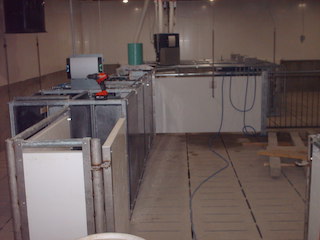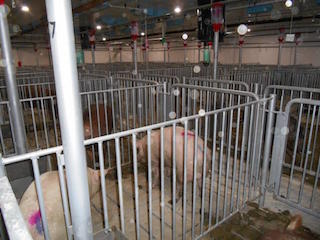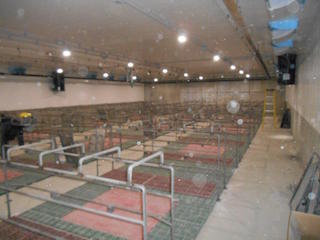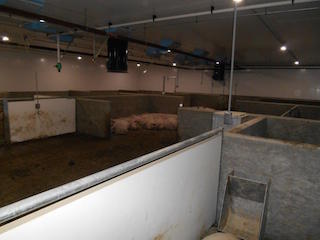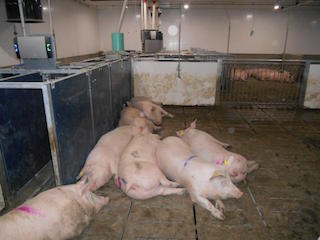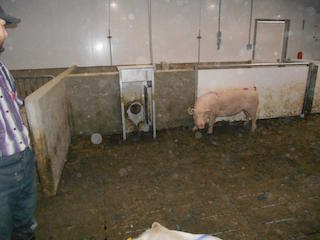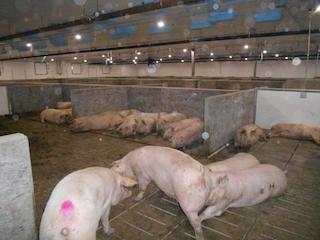In a low-lying area just southeast of the town of Kyle, Sask. there is a bit of history being made: Yes, new history – the first ever complete loose housing facility being built in Saskatchewan, at the home of the former Matador co-operative farm.
History is prevalent in and on the future site of a new colony that is still in the planning stage.
Sam Waldner, one of the hog managers at Kyle Colony, shared the background story with Laurie Brandly, publisher of Prairie Hog Country.
The Matador Farming Pool was the last remaining co-operative farm in Saskatchewan, established with the help of the first CCF Government elected in 1944, as communities whose land and assets were all owned and farmed co-operatively.
The total number of co-operative farms in Saskatchewan peaked at 32 in 1952, and steadily declined after that year.
In its early years, the Matador farm was quite diversified, raising chickens, turkeys and pigs as well as keeping a herd of dairy cattle for personal and commercial use.
The farm was first settled in 1944 by 17 Second World War veterans on a portion of the former Matador Land and Cattle Company.
As many as 50 people lived at the Matador at one time. There was a school on site, which closed in 1964, and even a general store.
Looking further back to the late 1800’s, this exact land – 30,000 acres in all – was leased from the Saskatchewan Government to a Texas land company and used as pasture land.
The Matador was sold to the Kyle Colony in the fall of 2011.
Initial plans for a new hog barn started in January of 2014, says Jeff Ironside of Saskatoon-based K & J Services, with ground breaking that April.
“The building is still being worked on and should be completed by August of this year,” said Ironside.
K & J Services teaming up with New Standard West were contracted to equip the new barn. They supplied the materials and the Colony provided the labourers.
The new pig barn will be home to 600 sows farrow-to-finish and will measure 163 feet by 615 feet overall, covering 2.3 acres.
“With loose housing being mandatory on all new barn constructions, it took longer to make construction plans,” says Waldner.
“There is an abundance of water on site, a great place to build a barn. The only negative thing (is) a bit of a low lying area so will be subject to early frost on the fields.”
There are six main sections within the barn: Breeding, farrowing, finishing, gestation, grower and nursery, complete with a Danish entry plus shower-in set-up.
The nursery is divided into six rooms measuring 77 by 18 feet with two pens per room, while the grower section has 10 rooms of 32 by 77 feet, again with two pens per room.
The finisher area has eight rooms, including one load-out at 40 by 77 feet, equipped with an automatic sorting system.
The breeding area is 117 feet long by 55 feet wide, divided into 77 pens with a gilt developer room to house 90 to 110 gilts at 29 by 54 feet and including a self-training station.
Gilt multiplication is performed in house with gilts to be selected at 70 to 80 days old.
Each farrowing room includes 27 crates and there is one overflow room with nine farrowing crates.
Two large pens of 45 by 107 feet house 180 sows each and there is a single pen for gilts, housing 120 animals in a space measuring 46 by 64 feet.
“After looking at numerous alternatives for loose housing, the Nedap system was chosen as we felt it best fit our plans,” said Waldner.
The sows will each have an electronic ear tag that will provide feedback to the electronic feeding system.
The sow system includes a total of 11 feeding stations, each of which will feed 40 – 50 animals. Each sow’s body condition can be precisely controlled by giving her exact allotments of feed.
Feeding stations are also set up to sort sows for vaccinations, pre-farrow and pregnancy testing.
The system is equipped with a heat detection return station that can record sows that have visited the boar station.
Crystal Spring Hog Equipment’s wet-dry feeders are used in all other sections of the barn, with the nursery including a water spacer to help with the newly-weaned piglets.
Ventilation is handled with a dual system for both summer and winter, supplied by Dynamic Air Micro fans and using three-phase frequency controls with measuring fans. The system features low energy consumption and precise ventilation control.
The walls of the barn are 9.6 feet tall. They’re constructed with a four-foot high cement styrofoam lined section, and a PVC liner above four feet up to the ceiling.
Ceilings in the farrowing and nursery rooms also have PVC liners, while the roofs in all other areas have painted surfaces.
To help keep the piglets warm, hot-water heating pads with temperature curves are used in farrowing crates instead of heat lamps.
The barn is stocked with Fast gilts and boars. As of March 17, 320 gilts and 50 boars had been moved into the barn.
The manure system is an earth lagoon with a pull plug system and a capacity of 20,000,000 gallons. The lagoon is based on a three-stage system and serves the entire colony, including the hog barns, dairy and household.
Ken and Ryan Waldner will be in charge of the new barn, a task they are very excited about.
“The goal is to build an entire Colony at this site,” says Sam Waldner.
“It will take four to five years to finish building the entire Colony.”
Members of the Kyle Colony held an open house on Feb. 3 at Matador to give other producers and suppliers a look at their new facilities and the innovations within its walls.
“So many guys wanted to come see the barn, so at the last minute we decided to host an open house,” said Waldner.
Despite getting only two-day’s notice, about 400 people attended, including representation from Prairie Swine Centre and Sask Pork.
“The gilts are almost self-training with the new feeding system. It doesn’t take them long,” says Waldner. “Breeding has also begun.”
Noise from the feed augers does startle them the first few times they use the electronic feeding system, but that issue subsides quickly as they the learn how it works, he says.
The goal in mid-March was to have the first batch of pigs ready to ship in late October or early November. It had not been determined at press time whether they will go to Olymel or Maple Leaf. •
— By PHC Staff
Thanks to Brad Gampe of Fast Genetics and Jeff Ironside of K & J Services
for supplying pictures.

